As video infrastructure starts its steep decline in sales, the Lifesize Cloud announcement and Cisco's impending Collaboration Meeting Room, come as no surprise to me. In both cases, the transition from "big iron" to services is designed to maintain market share. It's great news, and a coming of age for all of us with established cloud video services. And here's the "but": Just like the infrastructure they aim to replace, not all cloud services are equal. There are many variations that can trip up the end user, so here are my top tips for what to demand from a cloud service:
1. Scheduled conferencing and ad hoc calling--In one service please!
Seriously, choose a service with both capabilities. Scheduling has to be easy, via a Web portal, and accessible to all employees at no extra cost. Calendar integration is essential (and somewhat obvious), and so, too, is global-audio dial in for conferences.
What made the telephone so pervasive? The ability to simply call someone without pre-arrangement; this is just as important for video. Users must be able to instantly video-call anyone at anytime. Without this, you have restrained video and have no way for users to jump on a video call straight away. You might as well stick with the phone!
2. Interoperability--Full on and every which way
Only consider services that allow people to use any system to call anyone else on any hardware or software video endpoint, from any manufacturer. Make sure your provider supports SIP, H.323 and Microsoft Lync across its devices and yours (BYOD). Also make sure they have a track record of bringing new technologies on board, such as WebRTC. Ensure support for firewall traversal and easy dialing--both for its own hardware and software, but also for those of other manufacturers--don't be forced to rip-and-replace just because you want a new service.
3. Security--Never to be underestimated
Require industry standard encryption and authentication for all calls. Demand a service that does not scare your firewall administrator with unrealistic demands, such as needing to open large numbers of ports on your network. Ideally your solution will "just work" without any changes to your firewall rules.
Ensure the provider is in full control of its datacenters and does not rely on others to provide this hugely important part of its service.
4. Integrated appliances--A perfect world
In the perfect cloud, video endpoints are tightly coupled to the service. Here the endpoints are continually enhanced--so make sure the provider has a record of innovation with automatic delivery of must-have features. At a minimum, ensure automatic firmware updates, integrated scheduling and one-touch-to-join-a-conference are provided.
There needs to be a full range of appliances to fit all needs--from the desktop to the boardroom. Professional AV and AMX/Crestron support should be available, and all endpoint settings must be controllable from the cloud. Together with this, multiple logins for your management portal should be available to allow you, your IT staff, reseller or other partners to support your deployment, without requiring you or an onsite presence to address any configuration fixes or changes.
Finally, in my perfect world, easy provisioning becomes available, removing all notion of traditional settings to do with gatekeepers, registrars, etc., which only cause support and usability issues.
5. Quality--Choose wisely as it's never guaranteed
When using the Internet as a transport network, the cloud provider must guard against packet loss. Make sure multiple approaches are used--as one or two is never enough. Look for forward error correction, robust codecs such as SVC and AAC-LD and dynamic bandwidth management.
Another factor that affects quality is latency. This is greatly improved by having the media flow directly between endpoints where possible, rather than always traversing the Internet, and by having points-of-presence in your vicinity.
Ease of use is critical to the quality of the experience. If a user cannot figure out how to call someone, it doesn't matter how good the video would have been. So consistent user interfaces, one-touch dialing and an automatically-generated corporate directory are essential.
6. Cost of ownership
It's true that with the cloud you'll no longer be dealing with the expense and maintenance of big metal, but pricing models from one cloud vendor to another vary greatly. Some charge by the minute and/or by the user, while others offer a flat rate.
With such pricing variations you'll find it difficult to compare apples with apples. However, if you steer clear of per user and per minute pricing, you will not be facing a massive bill should your deployment turn out to be very successful. Look for a provider that allows you to scale video by opting for a model where adding users does not add cost. Really, your business should look for a flat rate with predictable costs, and this should allow for unlimited calling and conferencing with no surprises.
William MacDonald is CTO of StarLeaf.






